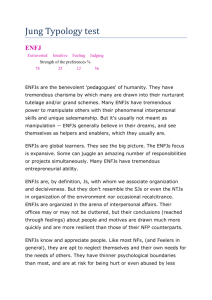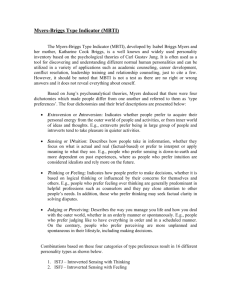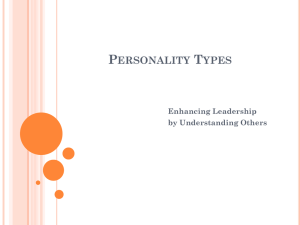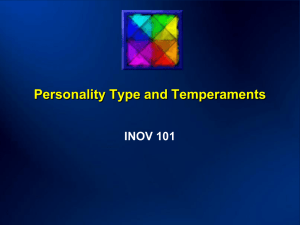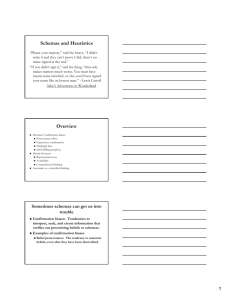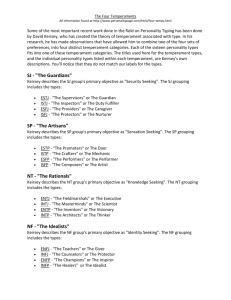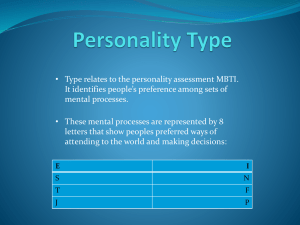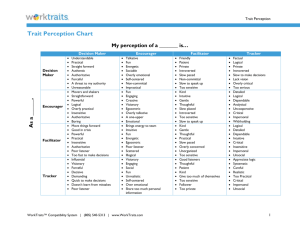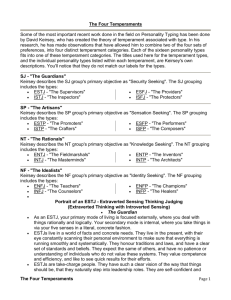Eight Function Attitude - Center for Applications of Psychological Type
advertisement
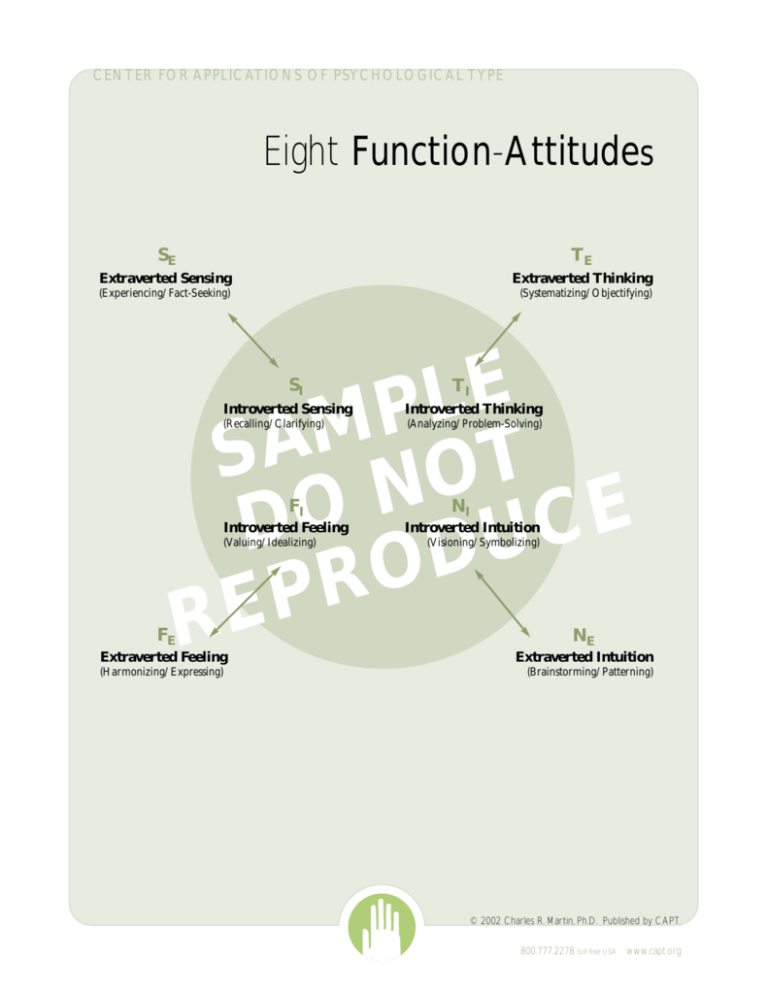
CENTER FOR APPLICATIONS OF PSYCHOLOGICAL TYPE Eight Function-Attitudes SE TE Extraverted Sensing Extraverted Thinking (Experiencing/Fact-Seeking) (Systematizing/Objectifying) E L P M SA NOT DO DUCE O R P E R SI TI Introverted Sensing Introverted Thinking (Recalling/Clarifying) (Analyzing/Problem-Solving) FI Introverted Feeling (Valuing/Idealizing) NI Introverted Intuition (Visioning/Symbolizing) FE NE Extraverted Feeling Extraverted Intuition (Harmonizing/Expressing) (Brainstorming/Patterning) © 2002 Charles R. Martin, Ph.D. Published by CAPT. 800.777.2278 toll-free USA • www.capt.org SE Extraverted Sensing (Experiencing/Fact-seeking): Outward and active focus on the objective world and on gathering and sharing factual data and sensual experiences. Characterized by: quick responsiveness to the environment, realism, present-orientation, excitement at anything that stimulates the senses, concrete language and factual speech. SI Introverted Sensing (Recalling/Clarifying): Inward and reflective focus on subjective sensual experiences and on the storing of factual historical data. Characterized by: clarifying of facts, attention to past associations and experiential memory, recall of physical world memories as “snapshots,” and attention to bodily sensations. NE Extraverted Intuition (Brainstorming/Patterning): Outward and active focus on the new, the possibilities, and meanings/patterns in the objective world. Characterized by: attention to the world of ideas, symbols and possibilities, brainstorming activity, noticing and making “connections” while watching the world or by talking out loud, adaptability and opportunity-seeking, and an orientation to change. E L P M SA NOT DO DUCE O R P E R NI Introverted Intuition (Visioning/Symbolizing): Inward and reflective focus on the subjective world of symbols, meanings, insight, and patterns that come up from the unconscious. Characterized by: vision, attention to “psychic,” even mystical realities; metaphor in thought and words; possibilities in the world of ideas; complexity; symbolic language; multiple perspectives; and an orientation to the future. TE Extraverted Thinking (Systematizing/Objectifying): Outward and active focus on applying logical order to the objective world through building structure, organizing, and making decisions. Characterized by: cause-and-effect thinking, establishing objectively defining and ruling principles, planning, logical debate and critiquing, and analysis of pros and cons. TI Introverted Thinking (Analyzing/Problem-solving): Inward and reflective focus on the subjective world of reason that seeks understanding through finding the logical principles behind phenomena. Characterized by: giving order to ideas (rather than objects), seeking the “truth,” tough-minded (and often categorical) analysis, logical precision, making conceptual linkages, reliance on and trust in own logic that may go against the “norm.” FE Extraverted Feeling (Harmonizing/Expressing): Outward and active focus on bringing order to the objective world through building and seeking harmony with others and alignment with openly expressed values. Characterized by: expressing warmth and empathy, relationship-seeking, emotional responsiveness, sensitivity to social mores, harmony in relationships, attention to expectations in relationships, and consideration and acceptance of others. FI Introverted Feeling (Valuing/Idealizing): Inward and reflective focus on the subjective world of deeply felt values that seeks harmony through alignment of personal behavior with those values and evaluation of phenomena in light of those values. Characterized by: attention to ethical concerns, drive to fulfill deeply passionate ideals, seeking of abstract universal values, trust in one’s own values and evaluations of right and wrong that may go against the “norm.” 2 © 2002 Charles R. Martin, Ph.D. Published by CAPT. 800.777.2278 toll-free USA • www.capt.org Eight Function-Attitudes:What Are They? Carl Jung originally identified four different kinds of extraverts and four different kinds of introverts, eight types in all. What distinguished the different types of extraverts and introverts was their emphasis on one of four mental functions, functions which could be understood as pairs of opposites: two perceiving mental functions (sensing vs. intuition), and two judging mental functions (thinking vs. feeling). Perceiving functions take in information, while judging functions weigh information and decide. Each of the eight types identified by Jung use their favorite of the four mental functions (sensing, intuition, thinking, or feeling) in a particular attitude—that is, they use that favored function in either an extraverted or introverted way. A function used in a particular attitude is what we refer to as a function-attitude. The diagram of the eight function-attitudes in this handout represents these functions in a visual way. E L P M SA NOT DO DUCE O R P E R Everyone uses all eight of these function-attitudes. What makes someone a type is that one of the function-attitudes is dominant (the characteristics of that function show significantly in that person’s life) and that one of them is auxiliary (that function supports and balances the dominant function). The favored—or dominant—function tends to be the individual’s most well-developed function and the one that leads the personality. The second-favored—or auxiliary—function tends to be the second most well-developed function and is given secondary weight to the dominant. Each of the eight dominant function types have two variations (one of two auxiliary functions), leading to sixteen different types. The sixteen types, with their favored dominant function, their second-favored auxiliary function, and their least preferred (inferior) function are listed on the next page. 3 © 2002 Charles R. Martin, Ph.D. Published by CAPT. 800.777.2278 toll-free USA • www.capt.org DOMINANT AUXILIARY LEAST PREFERRED ESTP Extraverted Sensing (SE) with Introverted Thinking (TI) Introverted Intuition (NI) ESFP Extraverted Sensing (SE) with Introverted Feeling (FI) Introverted Intuition (NI) ISTJ Introverted Sensing (SI) with Extraverted Thinking (TE) Extraverted Intuition (NE) ISFJ Introverted Sensing (SI) with Extraverted Feeling (FE) Extraverted Intuition (NE) ENTP Extraverted Intuition (NE) with Introverted Thinking (TI) Introverted Sensing (SI) ENFP Extraverted Intuition (NE) with Introverted Feeling (FI) Introverted Sensing (SI) INTJ Introverted Intuition (NI) with Extraverted Thinking (TE) Extraverted Sensing (SE) INFJ Introverted Intuition (NI) with Extraverted Feeling (FE) Extraverted Sensing (SE) ESTJ Extraverted Thinking (TE) with Introverted Sensing (SI) Introverted Feeling (FI) ENTJ Extraverted Thinking (TE) with Introverted Intuition (NI) Introverted Feeling (FI) ISTP Introverted Thinking (TI) with Extraverted Sensing (SE) Extraverted Feeling (FE) INTP Introverted Thinking (TI) with Extraverted Intuition (NE) Extraverted Feeling (FE) ESFJ Extraverted Feeling (FE) with Introverted Sensing (SI) Introverted Thinking (TI) ENFJ Extraverted Feeling (FE) with Introverted Intuition (NI) Introverted Thinking (TI) ISFP Introverted Feeling (FI) with Extraverted Sensing (SE) Extraverted Thinking (TE) INFP Introverted Feeling (FI) with Extraverted Intuition (NE) Extraverted Thinking (TE) E L P M SA NOT DO DUCE O R P E R Additional Resources ◗ Lawrence, G. D. and, C. R. Martin 2001. Building people, building programs: Introducing the MBTI® to individuals and organizations. Gainesville, FL: Center for Applications of Psychological Type. ◗ Myers, K. D., L. K. Kirby. 1994. Introduction to type™ dynamics and development: Exploring the next level of type. Palo Alto, CA: Consulting Psychologists Press. ◗ Thompson, H. L. 1996. Jung’s function attitudes explained. Wormhole Publishing: Watkinsville, GA. Center for Applications of Psychological Type 2815 NW 13th Street • Suite 401 Gainesville Florida 32609 USA www.capt.org • 800.777.2278 toll-free USA 352.375.0160 • 800.723.6284 toll-free fax 4 © 2002 Charles R. Martin, Ph.D. Published by CAPT. 800.777.2278 toll-free USA • www.capt.org
